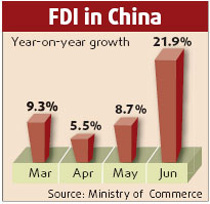It is a remarkable year for the mobile phone industry in 2007 - Nokia continues to be market leader, the launch of the revolutionary iPhone and Google's planned new mobile system.
In China, curbs on handset manufacturers have been relaxed and market share of home-grown firms has rebounded in the third quarter.
What's in store for the industry in 2008?
In the domestic market, the sales volume of mobile phone has reached 37.43 million units in the third quarter, a growth of 7.4 percent over the last quarter. Nokia led the market with 35.1 percent followed by Motorola with 13.6 percent and Samsung at 11.6 percent, according to Analysys International, a Beijing-based IT consulting firm.
The ultra-low end segment of the phone market where handsets cost less than US$40 each will grow rapidly, the firm said.
Rapid penetration of mobile phones in highly populated emerging markets is supporting the explosive growth in the ultra-low end handset market. The Asia-Pacific, central and eastern Europe, central and Latin America are the main markets for ultra-low end handsets. Handset companies cannot afford to ignore this spectacular growth, especially at a time when expansion in developed countries is tapering off, Merrill Lynch said in a recent report.
By the end of September, China's mobile phone penetration reached 39.9 percent, half the level of Western countries, according to the Ministry of Information Industry.
But the low-end models will be integrated with more sophisticated functions like multimedia, thanks to the development of the semiconductor industry.
"Our market share in China is several percentage points higher than the global level as demand surges for low-cost single-chip products LoCosto and eCosto," said Xie Bing, Texas Instruments' China president.
TI expects its under-US$20 chipset for multimedia mobile phones to have great potential in China, Xie said.
On the other hand, the premium (above US$300) and high-end (US$191-US$299) handset segments are also steadily increasing, Merrill Lynch said in a note.
"The handset industry is seeing a polarization of the low-end and high-end segments," the US-based investment bank said.
Digital convergence seems to be fueling growth in the market segment which combines multiple functions into one cell phone, such as Sony Ericsson Walkman Phone and Cybershot Phone (camera phone), while Apple's iPhone is regarded as the best invention of 2007 by Time magazine.
Other popular features include large high-definition screen, mobile payment and mobile TV in China, according to Beijing-based CCID Consulting, a research firm under the MII.
Co-branding between a luxury goods maker and a cell phone manufacturer will also be another potential area to tap. Examples of such alliances are LG's Prada phone and Samsung's tieup with Giorgio Armani.
Handsets will also become "smarter", thanks to the operating system, which runs the phone, and new software.
Nokia has adopted the Symbian-based OS which is by far the most-used system for mobile phones today. The Symbian is expected to be challenged by the evolution of lower-volume systems like BlackBerry's system, iPhone's Mac OS, Windows Mobile and Google's Android, which will be available in the second half of 2008.
Smart phone sales have accounted for one percent of all sales in China in the third quarter and are expected to grow significantly when 3G, or third generation, is available, according to CCID.
"Software companies are trying to attract end-users with their user-friendly and well-known software applications. For example, Apple's iPhone emphasizes its compatibility with iTunes," Merrill Lynch said.
Google, though without a wireless platform now, has also begun a mobile search service in China to test the water.
Global positioning system-equipped phones are another fledging market segment to explore.
(Shanghai Daily November 23, 2007)


